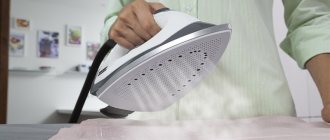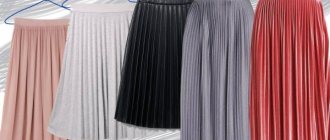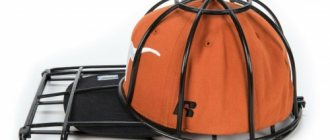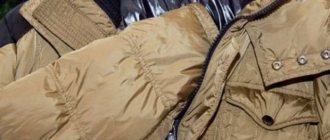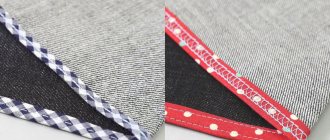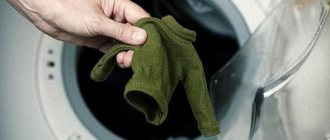Window decoration adds a special coziness to any room. In most cases, this is thin tulle, which is an airy, weightless fabric, which is often framed with thicker curtains or curtains. However, like any thing, tulle requires special care, being a delicate material. Sometimes one awkward movement is enough, and the textile product will be completely damaged. This is especially true for washing and ironing.
Depending on the type of fabric, care conditions may vary. We invite you to familiarize yourself with all the nuances of careful operation of curtains, and we will also tell you how to starch curtains, properly wash and quickly iron tulle even without an iron
How to iron tulle from different materials
Before ironing tulle, you need to clean the soleplate of the iron. Scorches and dirt must be removed so as not to spoil the delicate material. Before ironing, be sure to read the label to take into account the recommendations and properties of the fabric.
In this example (polyester). Ironing is allowed at temperatures up to 100 - 110 °C
Organza
Since the material is woven from very fine fibers, it must be handled with extreme care. There are several ways to carefully iron organza tulle:
- Steam treatment. The easiest and fastest way is to use a steam generator or the steam function on an iron. You need to hang the tulle on the cornice, and then walk along the entire section 1-2 times.
- Iron. The heating mode is selected depending on the composition of the organza. Iron semi-damp curtains from the wrong side through gauze.
- Hanging on a curtain rod immediately after washing. If the fabric does not straighten out, then moisten the folds and creases with water from a spray bottle, straighten them with your hands and leave to dry.
Advice! Organza made from natural silk should not be sprayed with water, as after drying, streaks remain on the fabric.
Capron
The fabric is made from polyamide fibers obtained from petroleum. It is not recommended to iron nylon tulle, as the material melts easily.
If a process is necessary, it is important to do it correctly:
- The nylon should be smoothed by barely touching it, or better yet, through a thin cotton fabric.
- You should not make smoothing movements to avoid stretching the fabric. The iron must be moved from place to place.
- Nylon should not be moistened during ironing or treated with a steam generator, as the fabric will stretch and become covered with waves.
Linen and cotton
Natural fabrics wrinkle easily, so even during washing you need to take care that the material does not deform. To do this, use the delicate mode and turn off the spin cycle. As a last resort, use the lowest speed.
It is best to hang cotton tulle to allow water to drain, and then attach it to the cornice and carefully straighten it out. When the canvas dries (it will take about 1 day), it will look freshly ironed.
If you cannot do without an iron, then you need to iron cotton tulle at 90-120 °C from the wrong side. For severe bruises, iron using a damp cloth.
Linen tulle is ironed at high temperatures, having previously been under-dried or moistened. As with cotton materials, they can be hung wet for a natural draw.
Veil
The delicate gauze-like fabric can be made from silk, cotton or even wool. But today, synthetic material is more often used for curtains. It is recommended to iron it only after washing, since any spot that is invisible to the human eye will be strongly attached to the iron.
To reduce damage to delicate fabric, do not twist or wring during washing. As soon as the water has drained, the tulle should be hung on the cornice, carefully straightened and left to dry.
If you need to iron, this can be done with a steam generator or an iron heated to a temperature not exceeding 110 °C. To prevent the fabric from stretching, it must be ironed through a thin cotton fabric, moving the electrical appliance from place to place and avoiding movements back and forth.
Polyester
The fabric is extremely difficult to care for, so even delicate washing does not always save you from bruises. In addition, synthetics do not have the ability to level themselves, so hanging them wet will not help. It is recommended to iron curtains under-dried or dampened from the inside out through gauze.
Viscose
An artificial material, the raw material for which is wood. It is better to steam viscose by hanging it on a curtain rod. If vertical processing is not possible, then the tulle is ironed on a board at 120 °C. You should not spray with a spray bottle, as water marks will appear on the canvas, and the material itself will become wavy.
How to wash curtains
Each type of fabric has its own washing characteristics. For example, polyester “feels great” in an automatic machine in normal mode at a temperature of 40 to 60 degrees. The same applies to nylon fabric, however, in its case the use of chemical bleaches is not recommended. But with organza and veil you should be more careful so as not to damage the product. The temperature should not exceed 30 degrees, and the mode should be set to delicate washing, or it should be done manually.
Tip : To add shine to curtains, add a tablespoon of vinegar to the drum of the washing machine.
However, there are a number of general rules for washing tulle curtains that will allow you to cope with the most difficult stains using the means at hand.
- Before washing, first simply shake off any dust from the curtains.
- The product should be pre-soaked for several hours in warm water with the addition of powder or salt (a tablespoon per 10-liter basin).
- When washing tulle by hand, do not rub it too hard; just slightly squeeze the material. But careful rinsing is required until the water becomes clear.
- When washing in a machine, place the product in a special bag or pillowcase. Set the temperature to 40 degrees.
- Do not pour a lot of washing powder so that the product is rinsed well and there are no streaks left on it. When hand washing, rinse first in warm water and finally in cool water.
White curtains are especially susceptible to contamination - dust or greasy stains are more visible on them if the curtains are hanging in the kitchen. Since digestion (boiling) is contraindicated for these fabrics, we suggest you consider several “folk” methods with which you can restore tulle to its former whiteness at home.
Method No. 1
To remove yellow plaque, you will need ammonia and hydrogen peroxide in a ratio of 1:3 (the amount is indicated in the size of a tablespoon). Pour the components into hot water (approximate temperature 60 degrees), into which the tulle is placed for 30 minutes. Afterwards, the product is thoroughly rinsed, carefully wrung out of excess moisture and hung on a stretched rope.
Method No. 2
Moisten the fabric and gently soap it with a bar of laundry soap (can be replaced with gel detergent). Pour 250 grams of baking soda (about half a standard pack) into a bowl of water - this will prevent the formation of “flakes” from the drug, soak the tulle in it for about 3 hours. After time has passed, place it in the washing machine compartment and set the “hand wash” or “silk” / “wool” mode.
Method No. 3
A rather extraordinary method of returning curtains to their original whiteness, but the result exceeds all expectations.
- The first stage involves soaking the fabric for a long time in a strong saline solution, which actively absorbs dust particles and gives a slight shine. Afterwards, you need to thoroughly rinse and wash the tulle with laundry soap. To secure the result, put the product in the washing machine.
- The second stage is bleaching using brilliant green. To do this, dilute a couple of drops of brilliant green and three tablespoons of table salt in five liters of warm water. It is very important here not to disturb the proportions - the solution should be only slightly turquoise in color. Leave the curtains in the basin for a couple of minutes. Afterwards, rinse thoroughly and hang to dry.
Tip : when bleaching, instead of green, you can use blue - 0.5 teaspoon per 10 liters of water or 1 cap in the washing machine.
Method No. 4
Whitening will take at least a day, but the result will please you - even an old yellowed curtain will sparkle white again. So, soak the curtain for 24 hours in water to which a packet of boric acid (available at the pharmacy) and a few tablespoons of baking soda have been added. Periodically rinse the fabric in this mixture. After the time has passed, wash the product on a delicate cycle.
Important : it is better not to use purchased modern bleaches, even with an “innovative formula”. These products give excellent results the first time they are used, but later the fabric will either collapse or turn yellow.
How to iron large fabric
You can cope with ironing a bulky curtain if you handle it in parts. The work will go quickly if you first smooth out the top part of the canvas and secure it to the cornice. After this, place the board in front of the window and continue ironing the rest of the canvas.
There is another way: as you iron it, wrap the tulle around a stick with a circular cross-section. The main thing is that it has a smooth surface, without chips.
Remember
- Study the shortcut. Do not neglect the instructions for a particular material; read the instructions on the label before washing and ironing. Perhaps the material should not be ironed at all.
- Do not iron at high temperatures . The maximum iron temperature is not higher than 150 °C.
- Do not wring out the tulle in the machine . Then you can hang the curtains on the cornice - they will straighten out under their own weight.
- Soften the material . To do this, rinse the curtains in a saline solution.
- Iron curtains while damp . If they are dry, first moisten them with your hand or a spray bottle to speed up smoothing.
The video shows ways to iron curtains after washing:
Types of tulle that do not require ironing
There are types of curtains that do not need ironing, or it is required extremely rarely. In this regard, the most convenient materials are those with a header effect. In addition to them, there are other types of curtains that do not need to be ironed:
- Synthetics. The fabrics are resistant to wrinkles, and after washing they can be immediately hung on the window.
- Cotton materials. The fibers are well saturated with moisture, so if you don’t wring out the tulle, but hang it up to drain, then they will straighten themselves without wrinkles.
- Linen fabrics. They are treated the same as with cotton tulle: they are not wrung out, they are hung wet. If wrinkles have formed, they should be sprinkled with water, smoothed out with your hands and not moved until dry.
Use a steam generator
Wide and long curtains, for example, large tulle, are problematic to iron on a board. When moving material from one place to another, it will become quite wrinkled.
To prevent the curtain from lying crumpled on the floor, you can do without an iron. After washing, the curtain is immediately hung in its place and steamed with a steam generator. It will steam and smooth out all formed wrinkles on any fabric.
The exception is synthetic and thin materials.
Only natural fabrics can be ironed with a steam generator; hot steam will damage synthetics. Photo: dekoriko.ru
Useful tips and care recommendations
Tulle is a delicate product that requires a special approach. Curtains will not have to be ironed (or it will be easier to do so) if during washing:
- Avoid twisting and hard friction.
- Washable at temperatures up to 40°C.
- use liquid tulle products.
However, tulle still has to be smoothed: some types more often than others. You can return the product to a presentable appearance with minimal effort if you follow the recommendations:
- Study the features of care, paying attention to the prohibiting icons.
- To prevent the fabric from deforming, iron slowly, without stopping the iron for long periods in one place.
- It is more convenient to iron large tulles folded in several layers, avoiding folds. After hanging, they are moistened and smoothed with palms.
Know the subtleties: 10 rules
High temperatures and steam mode should not be used on synthetic materials; the fabric will be damaged.
Photo: cdn.doers.video In order not to spoil the thin tulle material with high temperatures, but at the same time iron it efficiently, you need to:
- Study the shortcut. The markings on the label will tell you how to care for curtains and curtains without ruining them.
- Understand that not all fabrics need to be ironed. For example, cotton can dry under its own weight right on the eaves in the room.
- Do not overdry the fabric. Dried material is more difficult to iron. After washing, it is better not to let the tulle dry and leave it slightly damp.
- Do not exceed 150° C when ironing. Synthetic materials are ironed at a temperature of 100–120 °C, natural ones - at 150 °C. If these are multi-layer curtains, then the temperature is selected in accordance with the layer that you plan to iron.
- Use gauze. To properly and efficiently smooth out folds on the curtains, you need to moisten the gauze with water.
- Do not hurry. The faster you move the iron over the material, the higher the likelihood that creases will remain on the fabric.
- Check the cleanliness of the iron before ironing. Otherwise, carbon deposits on the soleplate of the iron will stain the curtains.
- Iron seams right side out. This should be done with the edge of the iron. If you iron the seams from the inside out, unsightly bulges will remain on the front side.
- Do not keep the iron in one place for a long time . Thin fabric may deteriorate - it will be burned or yellow spots will remain on it.
- Do not turn on steam mode . Steam causes unsightly waves to appear on some fabrics.
To iron curtains quickly and easily, they need to be dampened. Photo: mult-clean.ru
How to iron tulle without an iron?
It happens that it is not possible to use an electrical appliance, but you need to hang tulle. In this case, several ways will help:
- If the bruises are not severe, they can be smoothed out with wet palms.
- Hang the wet tulle on the cornice, straighten it, and leave to dry.
- Hang the tulle in a bathtub filled with hot water and leave until it straightens.
- Fill a glass bottle or other container with hot water and lay the tulle on a flat surface. Smoothly move the container over the fabric, ironing out the folds.
If bruises are discovered after hanging the tulle, it’s not a problem. You can deal with folds without removing the curtain from the curtain rod:
- If the tulle is still damp, then you need to let it hang, then iron the unevenness, turning on the steam function, or use a steam generator.
- Boil the kettle, and while the steam is flowing, direct the stream to the folds.
- Spray the bruises with a smoothing agent (mix equal parts vinegar, water, fabric softener) and leave to dry.
Despite the complexity of the work, it can be handled. Studying the composition of the fabric and knowing the nuances of caring for it will help you find a suitable way to smooth out tulle without much effort.
Quickly iron the tulle
There is no fabric that does not wrinkle. I introduce you to three tips that I have successfully used in practice:
- Hanging. Curtains that have been washed but not wrung out automatically are hung on the curtain rod. Make sure that no creases form on the fabric - smooth out all the folds. The tulle will straighten completely and dry in 1–2 days.
- Steaming. A steam generator is needed here. Steaming should be carried out two or more times. Tulle smooths out wrinkles before your eyes.
- Saline solution . It will help you smooth out tulle without difficulty. After washing, rinse the curtains in a salty solution - 50 grams of salt per 10 liters of water.
Advantages:
- the curtain is easier to iron;
- no static electricity;
- There are no water stains on the fabric.
Rinsing tulle in a saline solution will make the fabric softer and more pliable: 50 grams of salt per 10 liters of cool water. Photo: neosensys.com
Technical alternative
In order not to use an iron, without excluding the use of technical means, you can “cheat” a little. There are similar devices that work differently. These are steamers, steam generators and similar household appliances.
Steamer
This is the name of an electrical device that allows you to produce steam from water. The working fluid is fed into the steam chamber in portions, then gets onto the clothes. They can be vertical, universal in design or manual. The disadvantage of a steamer is that it cannot completely replace an iron - it will only straighten out wrinkles.
Steam generator
The principle of operation of a steam generator is similar to a steamer, differing from it only in performance. The significant dimensions and weight of the device do not allow you to take it with you on a trip. More often these are stationary units, sometimes they are used in professional studios or shops.
Is it possible to hang it without removing it?
give tulle a neat look without removing it from the cornice :
Ironing.
The damp curtain is hung on the curtain rod and allowed to hang for some time so that it straightens under the weight of its weight. Next, use the steam function. By exposing the tulle to steam, it is possible to smooth out any creases and other irregularities.- A steamer is the best way to iron a curtain without removing it from the curtain rod. You need to move the steamer slowly over the curtain.
- If you don’t have a steamer at hand, you can replace it with a container of boiling water. It needs to be brought to the curtain and moved along the entire canvas.
Ironing instructions after washing
To ensure that there are fewer creases on clean tulle, you need to wash the product correctly :
If the fabric is not too dirty, then choose the delicate mode.- The water temperature should not exceed 40 degrees.
- The spin mode is set to minimum speed.
- It is advisable not to use the drying mode.
- To make the material look smoother, it is recommended to add fabric softener to the machine.
If the tulle is cleaned manually, then add fabric softener during the last rinse.
Afterwards, the fabric is hung on a rope and excess water is allowed to drain. There is no need to unscrew it so that additional creases do not form. When the water has drained, hang the damp cloth and smooth it with your hands.
How to properly wash tulle by hand so that you don’t have to iron it later - in the video:
To tidy up large tulle items (curtains, tablecloths) that are difficult to iron on an ironing board, use the following ironing methods:
- In the fresh air . The material is dried outside, thrown in half over a rope. In this case, it is advisable to straighten all the folds and secure the position with clothespins. After a few hours, the product will level out, all that remains is to remove the creases where the clothespins were.
- Using a steamer .
A clothing steamer can iron straight and complex-cut garments with many layers within half an hour. A clean, slightly damp item is hung and steamed in a vertical position. It is recommended to direct steaming using downward movements (exclusively from top to bottom). You should not linger in one area for a long time, as this can damage the material.
Using steam in the bathroom .
Washed and dried items can be ironed over the bathtub. To do this, pour hot water into the container (at least 80 degrees). Tulle is pre-hung over the bathtub. The room is closed for half an hour, after which the wet product is hung up and allowed to dry naturally.- Cold water . Dry, clean tulle is laid out on a flat surface (sofa or bed). Fill the spray bottle with tap water. The material is sprayed over the entire area and rubbed over it with palms from the center to the edges. Allow to dry.
- Ladle or other vessel . In order to iron the tulle, it is laid out on an ironing board. Boiling water is poured into the ladle. Half the capacity is enough. With smooth movements, the hot metal utensil is moved over the fabric, smoothing out wrinkles.
The methods recommended on the Internet using a wet towel placed on crumpled tulle, as well as leveling the material under the mattress, are quite controversial. Many users rate them as ineffective.


